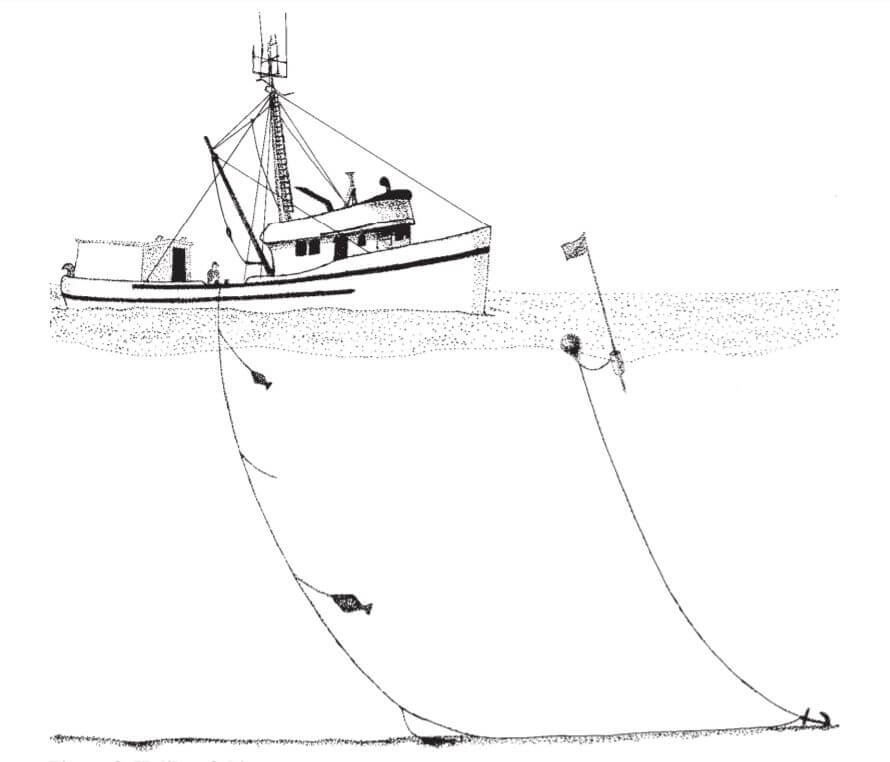Pacific halibut commercial fishing fleet is diverse and uses various strategies to harvest the resource. In British Columbia and Alaska, the industry is managed with individual quota (IQ) systems ensuring catch within annual limit. Commercial fisheries in Washington, Oregon, and California range from a directed commercial derby fishing to Pacific halibut caught incidental to sablefish and salmon fisheries.
A typical Pacific halibut fishing trip in today’s fishery begins with the vessel taking on several tons of crushed ice so that the catch can be chilled near, but usually not below, the freezing point. Once the vessel reaches the fishing grounds, the gear is set, left to soak for several hours, and then hauled back aboard. As the Pacific halibut are brought aboard, they are often stunned and then cut in the gill area to induce bleeding and create a better product. Pacific halibut are dressed soon after capture by removing the viscera and gills. The body cavity, or “poke”, is scraped, washed, and sometimes filled with ice. The head is not removed until the catch is delivered dockside. The fish are stored in the hold in layers separated with crushed ice. Many vessels now have refrigeration that reduces the amount of ice needed and maintains a lower and more uniform temperature in the hold. Some vessels have refrigerated sea water or an ice/seawater mixture in which they store the fish. The fish are then delivered to a dockside plant where they are cleaned, possibly headed and either frozen or shipped fresh to buyers. The mechanics of capturing, cleaning, and storing Pacific halibut at sea in the commercial fishery have changed little over time. However, technological advances, steel-hulled vessels, modern electronics, and improved gear (particularly circle hooks and stronger fishing lines), have made fishing efforts more efficient and has allowed the fishing fleet to capture Pacific halibut throughout the entire extent of their geographic and depth distribution.
For details on how the Secretariat samples landings from these fisheries, please refer to the following manual:
Document
Title
Availability
Commercial fisheries data can be found in the IPHC data library.

Directed commercial fishery in IPHC Regulatory Area 2A
IPHC Regulatory Area 2A is located off the USA West Coast in waters off Washington (WA), Oregon (OR), and California (CA). IPHC sets the overall mortality limit for the area. The IPHC Regulatory Area 2A Catch Sharing Plan as put forth by the Pacific Fishery Management Council and the National Oceanic and Atmospheric Administration (NOAA) Fisheries provides the formulas to then allocate Pacific halibut among user groups in IPHC Regulatory Area 2A.
The directed commercial fishery in this IPHC Regulatory Area consists of:
- Directed commercial fishery
- Incidental commercial Pacific halibut fishery during the sablefish fishery
- Incidental commercial Pacific halibut fishery during the salmon troll fishery
Permits
The NOAA Fisheries final rule (87 FR 74322) implementing the management transition in the IPHC Regulatory Area 2A to the NOAA Fisheries was published on 5 December 2022 and became effective on 4 January 2023.
As of 2023, commercial vessels retaining Pacific halibut in IPHC Regulatory Area 2A must obtain a permit from NOAA Fisheries.
Online permit application forms are available through the NOAA Fisheries West Coast region web page.
Directed commercial fishery in IPHC Regulatory Area 2B
Open: 20 March 2025 at 06:00h local time
Close: 7 December 2025 at 23:59h local time
IPHC Regulatory Area 2B is located off the coast of British Columbia, Canada. The IPHC sets the overall total allowable catch and season (called the “fishing period” in IPHC regulations) for the area. Fisheries and Oceans Canada (DFO) then allocates Pacific halibut among user groups in IPHC Regulatory Area 2B. Canada’s directed Pacific halibut fishery operates under an individual vessel quota (IVQ) system, where each licensed vessel is allocated a percentage of the IPHC Regulatory Area 2B fishery limit to harvest at any time over the commercial fishing period. In 2006, Fisheries and Oceans Canada (DFO) implemented a Groundfish Integrated Fisheries Management Plan (IFMP), where all vessels are accountable for all of their catch, both retained and discarded. All hook-and-line vessels, even those not officially licensed as Pacific halibut vessels, can retain and sell Pacific halibut as long as they have Pacific halibut quota shares to cover their catch.
Directed commercial fishery in IPHC Regulatory Areas 2C, 3 and 4
Open: 20 March 2025 at 06:00h local time
Close: 7 December 2025 at 23:59h local time
IPHC Regulatory Areas 2C, 3 and 4 are located in Alaskan waters. The IPHC sets the overall total allowable catch and season (called the “fishing period” in IPHC regulations). The North Pacific Fishery Management Council and the NOAA Fisheries then allocate Pacific halibut among user groups, some through Catch Sharing Plan. Alaska’s directed Pacific halibut fishery operates under an individual fishing quota (IFQ) system, where each permit holder is allocated a percentage of the specific regulatory area’s catch limit to harvest at any time over the commercial fishing period. Pending Alaska Landing Information
Resources
Pacific Fishery Management Council NOAA Fisheries West Coast Region Fisheries and Oceans Canada- Landing Activity
- Pacific Halibut Activity Report
- Integrated groundfish fisheries page
- Groundfish Integrated Fisheries Management Plan
- Rockfish Conservation Areas (RCAs)
- Marine Forecasts from Environment Canada
- Fisheries Catch and Landings Reports in Alaska
- Restricted Access Management Division
- Regulations, Acts, Treaties, And Agreements For Federal Fisheries In Alaska
- Cost Recovery Programs, Fee Collection and Fee Payment in Alaska
- Vessel Monitoring Systems (VMS) in Alaska
- Alaska Regulations on Seabird Avoidance and Listed Seabirds
- Alaska Marine Forecasts from the National Weather Service
